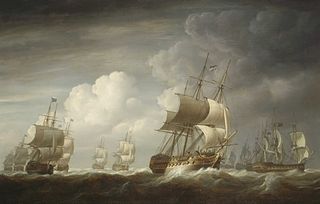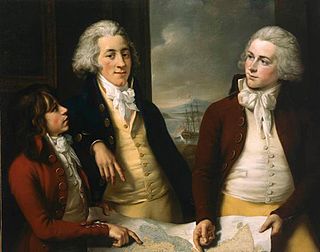Career
EIC voyage #1 (1787–1789)
Captain Robert Fairfull sailed from Portsmouth on 1 April 1787 bound for Madras and Bengal. Minerva reached Johanna on 6 July and Madras 30 July, and arrived at Diamond Harbour on 13 August. She was at Cox's Island on 15 December and Madras on 27 December. She returned to Bengal, at Ingelli on 26 January 1788. She sailed to Madras, where she arrived on 4 March, and then on to Bombay, where she arrived on 12 April. From Bombay she sailed to China, stopping first at Penang on 24 June. She arrived at Whampoa Anchorage on 1 August. Homeward bound, she crossed the Second Bar on 26 November, reached St Helena on 4 March 1789, and arrived at the Downs on 6 May. [2]
EIC voyage #2 (1790–1791)
Captain Fairfull sailed from Portsmouth on 5 January 1790, bound for China. Minerva reached Madras on 2 May and Penang on 27 June. She arrived at Whampoa on 5 August. Homeward bound, she crossed the Second Bar on 14 November, reached the Cape on 9 April 1791 and St Helena on 28 April, and arrived at the Downs on 27 June. [2]
EIC voyage #3 (1793–1794)
War with France had broken out shortly before Minerva was to sail on her next voyage. Captain Kennard Smith acquired a letter of marque on 7 March 1793. [4] he sailed from Portsmouth on 5 April 1793. Minerva arrived at Whampoa on 10 September. Homeward bound, she crossed the Second Bar on 18 November, reached St Helena on 11 APril 1794 and Galway on 20 July, and arrived at the Downs on 26 August. [2]
EIC voyage #4 (1795–1796)
Captain Smith sailed from the Downs on 24 May 1795, bound for Madras and Bengal. Minerva reached Madras on 2 September and arrived at Diamond Harbour on 5 October. Homeward bound, she was at Cox's Island on 4 December, Madras on 6 January 1796, and the Cape on 26 April. She reached St Helena on 30 May and arrived at the Downs on 3 August. [2]
EIC voyage #5 (1797–1798)
Captain Smith sailed from Portsmouth on 6 April 1797, bound for Madras and Bengal. Minerva reached Madras on 27 July and Penang on 12 October, and arrived at Diamond Harbour on 25 November. Homeward bound she was at Saugor on 28 February, Colombo on 1 April, and the Cape on 22 June. She reached St Helena on 5 August, and arrived at Long Reach on 22 October. [2]
EIC voyage #6 (1799–1800)
Captain Smith sailed from Portsmouth on 24 April 1799, bound for Madras and Bengal. Minerva reached Madras on 25 August and arrived at Diamond Harbour on 15 September. Homeward bound she was at Saugor on 7 December, the Cape on 27 April 1800, and St Helena on 9 June. She arrived at the Downs on 23 September. [2]
On one of the above voyages, Captain Smith suppressed a mutiny. He had had a man seized for punishment at the gangway. Some members of Minerva's crew rushed to cut the man down and rescue him. Smith drew his sword and severely wounded the ringleader. This ended the mutiny and the punishment was carried out.
EIC voyage #7 (1801–1802)
John Atkins tendered Minerva to the EIC in December 1800 to bring rice back from Bengal for Britain. The tender was accepted and Captain George Richardson acquired a letter of marque on 16 December. [4]
Minerva was one of 28 vessels that sailed on that mission between December 1800 and February 1801.
Captain Richardson sailed from Portsmouth on 12 February 1801 and arrived at Diamond Harbour on 21 June. Minerva was at Calcutta on 5 July and Fultah on 18 August. She reached St Helena on 3 January 1802, and arrived at the Downs on 22 February. [7]
On 30 March 1802 the Court of Directors of the United Company of Merchants trading with the East Indies (the EIC), announced that on 22 April they would offer for sale 37,000 bags of rice brought by Hind, Hope, Minerva, Ceres, and Bellona. [8]
Albion was an East Indiaman of the British East India Company (EIC). She made eight voyages for the EIC before she was sold to the British government in 1810 for service as a troopship. She was lost at sea in 1816.
Caledonian was launched on the Thames River in 1797. Between 1798 and 1803 she made two voyages to China and India as an "extra ship", i.e., under charter to the British East India Company (EIC). She sustained severe damage on the first. She burnt accidentally in 1804.
Hope was launched in 1797 on the Thames River. She made seven voyages for the British East India Company (EIC) before she was sold for breaking up in 1816. She was one of the East Indiamen at the battle of Pulo Aura.
Admiral Gardner was launched in 1797 as an East Indiaman for the British East India Company (EIC). She made five voyages for the EIC, during the fourth of which she participated in an inconclusive single-ship action with a French privateer. Admiral Gardner was wrecked in January 1809.
Bridgewater was launched in 1785 as an East Indiaman for the British East India Company (EIC), which engaged her for six voyages. She then made two more as an "extra ship", that is, under voyage charters, and was lost at sea homeward bound from Bombay on the eighth voyage.
Bengal was launched in 1799 as an East Indiaman for the British East India Company (EIC). She made four complete voyages but foundered in 1809 with no trace while homeward bound from the fifth.
Hugh Inglis was launched in 1799 as an East Indiaman. She made seven voyages for the British East India Company (EIC), between 1800 and 1817. In 1810 and 1811 she participated as a transport in two British military campaigns. She was sold for breaking up in 1817.
Britannia was launched by the Bombay Dockyard in 1772, and was rebuilt in 1778. The British East India Company (EIC) apparently acquired her in 1775. Between 1779 she made eleven complete voyages as an East Indiaman for the EIC. She also participated in three naval campaigns, during the first of which she was deployed as a cruiser off Sumatra. There she engaged and captured a French ship. In the other two served as a transport. She set out for her twelfth EIC voyage but was lost in 1805 during the third naval campaign.
Lord Castlereagh was launched on the Thames in 1802 as an East Indiaman She made seven voyages for the British East India Company (EIC) before she was sold in 1820. She then may have sailed one or twice to Bombay under license from the EIC. Her subsequent disposition is currently obscure.

Lord Hawkesbury was launched in 1787 as an East Indiaman for the British East India Company (EIC). She made eight voyages for the EIC before she was sold in 1808 for breaking up.
Melville Castle was launched in 1786 as an East Indiaman. She made seven voyages for the British East India Company (EIC). She was sold in 1802 to Dutch owners and wrecked with great loss of life later that year on her first voyage for them.
Carnatic was launched in 1787. She made six voyages as an East Indiaman for the British East India Company (EIC). She was sold for breaking up in 1802.
Dublin was launched in 1784 as an East Indiaman. She made six voyages for the British East India Company (EIC), to India and China. On her last voyage for the EIC she recaptured a country ship. Her owners sold Dublin in 1800 and she became a West Indiaman, but apparently was lost on her first voyage.

True Briton was launched in 1790 as an East Indiaman. She made seven voyages for the British East India Company (EIC). She was lost without a trace in 1809 during her eighth voyage.

Rose was launched in 1786 as an East Indiaman. She made six voyages between 1787 and 1800 for the British East India Company (EIC). She also participated as a transport for a military expedition to the West Indies. She then made one more voyage for the EIC, bringing rice back to England from Bengal. Next she sailed as a general trader, but also made one voyage seal hunting. She was last listed in 1820.
Castle Eden was launched in 1800 as an East Indiaman. She made six voyages for the British East India Company (EIC) before she became a transport in 1812 and disappears from online records.
Lady Jane Dundas was launched in 1800 as an East Indiaman. She made four voyages for the British East India Company (EIC) and was lost in 1809 on the homeward-bound leg of her fifth voyage. She and three other Indiamen parted from the homeward-bound convoy during a gale on 18 March 1809 and were never seen again.
Lady Burges was launched in 1799 as an East Indiaman. She made three voyages for the British East India Company (EIC) between 1800 and 1805. She was wrecked in 1806 early in her fourth voyage.
Worcester was launched in 1785 as an East Indiaman for the British East India Company (EIC). She made eight voyages to India and China for the EIC and participated as a transport in two naval expeditions before she was sold in 1809 for breaking up.
Walpole was launched in 1798 as an East Indiaman. She made four complete voyages for the British East India Company (EIC) and was in 1808 as she was returning to London from her fifth voyage.
This page is based on this
Wikipedia article Text is available under the
CC BY-SA 4.0 license; additional terms may apply.
Images, videos and audio are available under their respective licenses.


